
Author: Bridget Harris Source: Substack Translation: Shan Ouba, Bitchain Vision Realm
The availability layer has become an important part of the modular architecture, and acts as insertable components to reduce costs and expand the blockchain.The core function of the DA layer is to ensure that the data on the chain can be used and access to all network participants.Historically, each node must download all transaction data to verify whether the data is available -this is a task with extremely low efficiency and high cost.This is the current working method of most blockchain and is an obstacle to scalability, because the amount of data required to verify the linear linearity of the block.End users are suffering here: data availability costs account for 90% of the transaction costs generated by users on ROLLUP (90% of current Rollup currently send transaction data to Ethereum costs 1300-1600 USB/MB).
>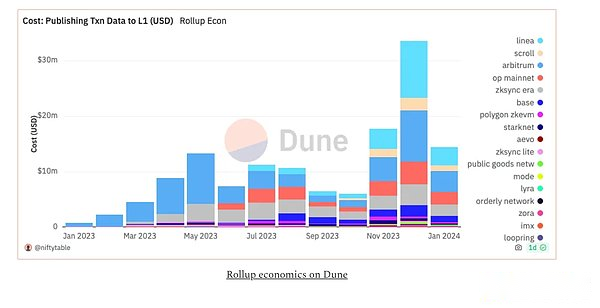
The introduction of data availability sampling (DAS) fundamentally changed this architecture.Through DAS, light nodes can be confirmed by multiple rounds of random sampling of block data to confirm the data available without downloading each entire block.Once multiple rounds of samples are completed and a confidence threshold that can be available for data available, the rest of the transaction process can be carried out safely.In this way, the chain can expand its block size while maintaining simple data availability verification.And also realized considerable cost savings: These emerging layers can reduce DA costs by up to 99%of Reduce DA Costs by UP TO 99%.
>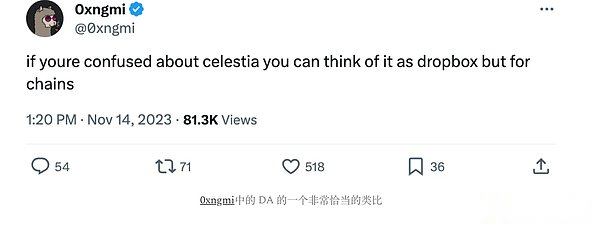
In addition to achieving higher throughput, the data availability layer is also very meaningful for improving interoperability.The cheap DA will inevitably push the Cambrian outbreak of the new custom Rollup chain, and it becomes more and more simple through the deployment of Rollup-As-AS-Service, such as Caldera, Altlayer, and Conduit.However, with the emergence of the L2 and L3 ecosystems, they will become fragmented by default.It is difficult to make users use a new platform -if interoperability, liquidity, and network effects are limited, the situation will become worse.The unified DA layer as the basis of each network will make the capital flow easier and attract a wider range of user base.
>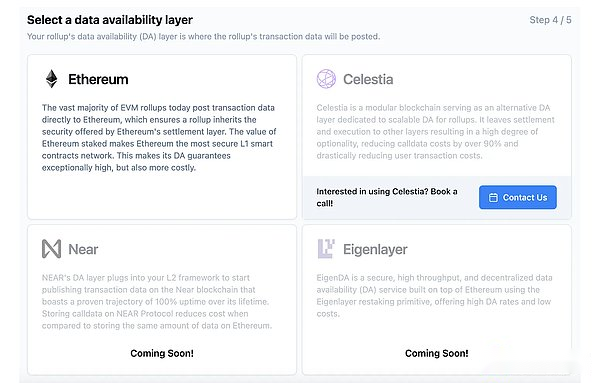
CalderaCaldra and other RaaS providers will enable the project to choose the DA layer when constructing a custom rollup
Avail Avail ,, EIGENDAEIGENDA and and CeleStiacelestia are the protagonists in the DA ecosystem -each serves the same space, but the methods taken in infrastructure stack, execution and listing are slightly different.
In terms of technical architecture, Avail, Ethereum, and EIGENDA use KZG promises, while Celestia uses fraud to confirm the block code to correct to confirm blocks are enac -correstly.Generating KZG proof -although it is a very strict way to prove DA -it will bring more calculation overhead to block producers, especially when the size of the block increases.On the other hand, Celestia assumes that data can be obtained through its anti -fraud scheme.As the exchange of “work” without completing the calculation, the system must wait for a period of time to perform the dispute period for fraud, and then the node can confirm that the block is accurate.KZG’s proof and fraud have undergone rapid technological progress; their balances may continue to become more complicated, and it is unclear whether one mechanism will be strictly better than another mechanism.
For Avail, they have the architecture of KZG’s commitment to make them very suitable for the ZK structure -this is the area where Celestia may face difficulties, because if ZK is dominant in the future, they depend on optimistic proof.In addition, Avail’s light client P2P network can support the network even when all the entire node is down; in the Celestia architecture, the light client cannot run without a complete node.Both Avail and Celestia use the deletion code under DAS (distributed storage), divide the data into fragments, increase redundancy, and allow the data to be reconstructed for verification.
>
Compared with the stack of Celestia and Avail, EIGENDA uses the existing infrastructure of Ethereum.If the data needs to be sent to a summary contract to prove that the data is available, the EIGENDA inheritance is the same final time as Ethereum.Inherits, but if Rollup uses Eigenlayer completely, it can be achieved faster faster.
>
In order to reach a consensus, Avail uses For Consensus, Avail Ueses Babe + GrandpaBabaBabaBaBaba + Grandpa, from Polkadot SDK.NPOS is used to nominate a group of verificationrs who are willing to elected by Serves to Nominate, and Babe stipulates who proposes the next block, and Grandpa acts as a block to finalize the algorithm.
Celestia uses Tendermint as a consensus mechanism that allows users to pledge their TIA to obtain the authenticated pledge reward.Although Celestia can achieve rapid determination through TENDERMINT, due to its Optimistic architecture, the actual data availability guarantee period (user must have time to submit fraud certificate).
EIGENDA has no consensus itself, but has two mechanisms to ensure the effectiveness of data usability:
-
Proved rights of monitoring.This is essentially an economic security mechanism that can ensure that the node stores data, but it does not actually guarantee that the data is provided to everyone in the network.If nodes do not comply with regulations, for example, if they cannot prove that they have data, the node will be cut.
-
Full power decentralizedEssenceEnsuring operators to maintain decentralization and anti -stringing are essential for the correct operation of the network.With a huge and independent authentication set, data services have become a competition that many market participants are willing to participate.Under this scale, it is extremely difficult to seek together.
One of the interesting points worth mentioning is that Celestia’s active authentication is composed of the top 100 pledges, and this threshold may be reduced in the future.In addition, each of their verifications store the entire data set.EIGENDA will optimize each node (in the future) that stores a small part of the data (in the future). Therefore, if enough nodes are honest, the data can be rebuilt.The complete origin (and more details) of EIGENDA can be found in the recent posts of Sreram.
>
Finally, Avail compares the core components of the main DA layer.
>
New discussions have also been discussed about the balance of each design.David Hoffman pointed out that Celestia itself is a complete blockchain -a complex stack, not just pure DA.On the other hand, EIGENDA is just a set of smart contracts, but it depends on Ethereum, and Celestia and Avail are not.
>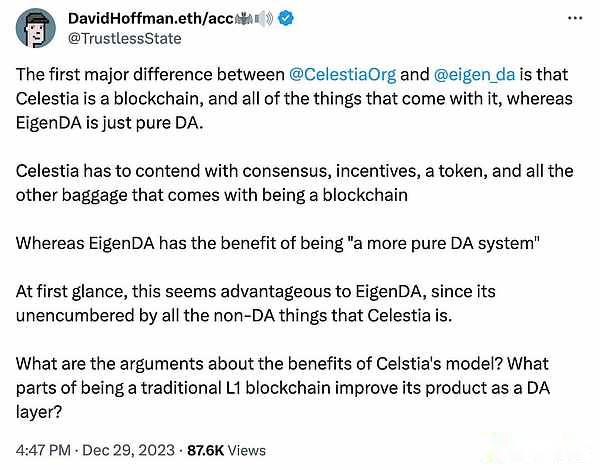
The Celestia team believes that token is necessary for security, and EIGENDA will eventually need tokens because it is impossible to cut the availability of data on the chain.They believe that in order to ensure that nodes are honest, data available and punished malicious nodes, the network must be able to verify through the incentive structure including native currency.Here, Celestia’s Nick White put forward criticism of EIGENDA: “Unless the source chain is split, the re -verification device retaining the data will not be SLASH -this is extremely impossible because it is Ethereum.”
>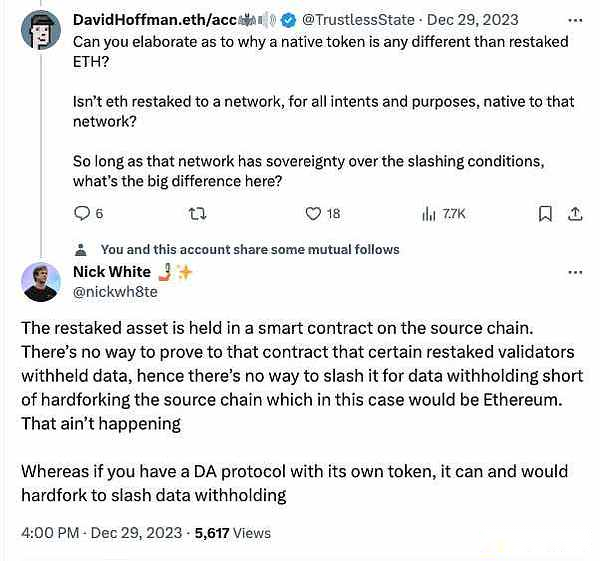
From a brand perspective, EIGENDA is an extremely consistent product with Ethereum.The EIGENLAYER team is constructed based on EIP-4844 and Danksharding-in Sreram’s words, Eigenda is built as “the only data availability layer centered on ETH”.He explained that according to the definition, the data availability layer is a modular product, but other DA “layer” is actually the blockchain itself.
Packing the DA layer into the blockchain will indeed bring obvious benefits to Rollups running locally, mainly the form of security assurance.However, Sreram mentioned that his team’s goal of building EIGENDA is to create a product, from the first principle to provide data availability services to the Ethereum ecosystem -a real “layer” adjacent to the Ethereum ecosystem.He pointed out that there is no need for a separate consensus here, because Rollup based on Ethereum has rely on the network to sort and consensus.(Sreram explained this in the recent Bankless show.)
Avail uses validity proof and DAS construction, which can achieve high degree of flexibility and interoperability in the ecosystem.Their architecture lays the foundation for the scalable framework, which aims to support services across many different platforms.This “impartial” position allows greater interoperability and capital flow, and also attracts an ecosystem centered on Ethereum.The ultimate goal here is to obtain orderly transaction data from all chains and gather them to Avail, making them a coordination center for all web3s.In order to launch the network, Avail recently launched node conflict activities at the same time as its incentive test network, allowing users to run verifications and light clients and participate in network challenges.
Celestia’s ecosystem is composed of RAAS providers, shared sorters, cross -chain infrastructure, etc., covering ecosystems such as Ethereum, Ethereum Rollups, COSMOS, and OSMOSIS.
>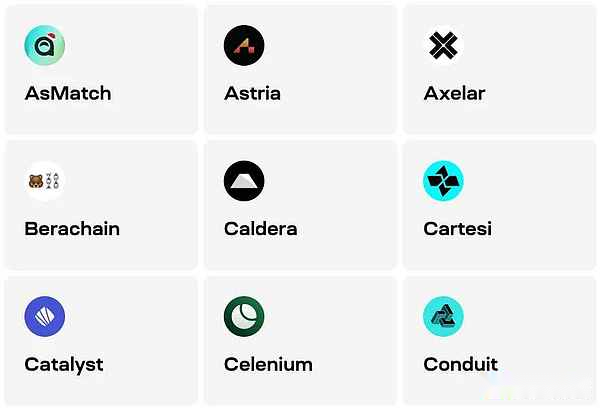
Celestia ecosystem page snapshot
Every of these design choices, both technical and marketing, accompanied by interesting weighing.Personally, I am not sure if the data availability classes will be a market for winners to eat or commercialized. On the contrary, there may be an oligopoly monopoly market, and the project will choose the DA layer that is most suitable for its needs.According to the type of agreement, the team can optimize the preferences of interoperability, security or preferences for a certain ecosystem or community.If the customized use case summary, they will not hesitate to integrate the DA layer -and there will be more than one option to choose from.
This technology -and the overall modular narrative -still relatively newer, Celestia has just launched recently, and Avail and EIGENDA will enter the main network in the next few months.However, the technological progress of modularistism so far is very good (many of them are just ideas a few years ago!).By improving our construction and using blockchain in essence, the DA layer will undoubtedly become one of the core technologies of this cycle and later cycle.








